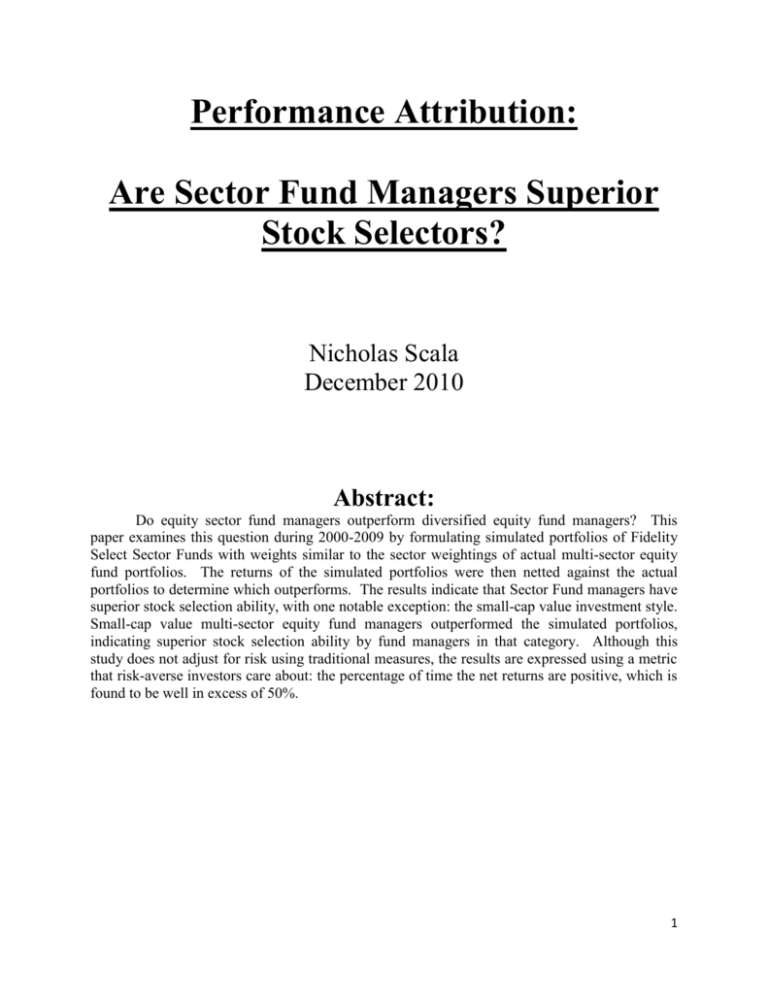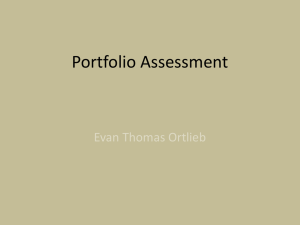Are Sector Fund Managers Superior Stock Selectors?
advertisement

Performance Attribution: Are Sector Fund Managers Superior Stock Selectors? Nicholas Scala December 2010 Abstract: Do equity sector fund managers outperform diversified equity fund managers? This paper examines this question during 2000-2009 by formulating simulated portfolios of Fidelity Select Sector Funds with weights similar to the sector weightings of actual multi-sector equity fund portfolios. The returns of the simulated portfolios were then netted against the actual portfolios to determine which outperforms. The results indicate that Sector Fund managers have superior stock selection ability, with one notable exception: the small-cap value investment style. Small-cap value multi-sector equity fund managers outperformed the simulated portfolios, indicating superior stock selection ability by fund managers in that category. Although this study does not adjust for risk using traditional measures, the results are expressed using a metric that risk-averse investors care about: the percentage of time the net returns are positive, which is found to be well in excess of 50%. 1 Performance Attribution: Are Sector Fund Managers Superior Stock Selectors? Introduction Actively managed diversified mutual funds are an important investment vehicle. They make up a significant portion of the assets held by pension plans and are a very popular financial intermediary for novice investors. It is surprising that this is the case since academic literature has shown that on average, actively managed mutual funds underperform passive benchmarks. Academic literature has also observed a fund manager’s ability to select undervalued stocks and time buys and sells based on market expectations. These studies suggest that only a limited number of fund managers have either selectivity or market timing abilities. A mutual fund category that has steadily grown in popularity over the last thirty years is sector funds. Sector fund managers seek above-average returns by specializing in one industry. The fund managers attempt to use their industry expertise to outperform industry benchmark indexes through superior stock selection. The investor chooses the industry of interest and the fund manager picks the stocks within that industry. Given that very few actively managed diversified mutual fund managers have shown selectivity or market timing abilities and that sector funds allow the fund manager to focus on one particular industry, the following question is developed. Are stock selection abilities superior for sector-fund managers than for diversified equity-fund managers? This study investigates the question by holding constant the sector allocation, leaving security selection as the sole variable for performance attribution. 2 Literature Review Some insightful research has already been completed that relates to the topic of this paper. Bodie, Kane and Marcus (2010) define portfolio performance attribution. The first step is to select a passive benchmark against which performance will be compared. The return on the passive benchmark is then compared to the return on the portfolio to determine which outperforms. Any departure of the manager’s return from the passive benchmark must be due to either asset allocation decisions (departures from the neutral allocation across markets) or security selection decisions (departures from the passive index within asset classes). Selection is then broken down further into two categories: sector allocation and security selection. In this study, asset allocation is at least 80% equity which makes asset allocation a very minor portion of the return. The excess return is then attributed to either sector allocation or security selection. Since the sector weights of the Fidelity simulated portfolios are identical to the weights of the multi-sector equity fund portfolios, this leaves security selection as the sole determinant of outperformance. Therefore, if the Fidelity simulated portfolios outperform the multi-sector equity fund portfolios, it is likely that sector fund managers have superior stock selection ability. O’Neal (2000) uses Fidelity Sector Funds to test the effect of industry momentum on stock returns. Momentum in stock returns is the tendency for well-performing stocks to continue to perform well and for poor performers to continue to perform poorly. O’Neal observes the returns of 31 Fidelity Sector Funds over a ten year period using three, six and twelve month lag and hold periods. He forms portfolios consisting of three to six funds, and ranks them as high, medium and low (based on performance). He finds that the various high portfolios outperform the S&P 500 in more than 50 percent of all months, quarters and years; and the longer the period, 3 the greater the frequency of outperformance by high portfolios. On the other hand, the non-highperforming portfolios continue to underperform the market in the following periods. The sector funds can not compete with the S&P in terms of risk adjusted returns as measured by the Sharpe ratio. However, since the sector funds are not diversified, we should not expect them to compete with the market portfolio in terms of standard deviation. The lack of diversification leads to a higher standard deviation and thus a lower Sharpe ratio. Given O’Neal’s findings that industry momentum is present in the highest performing sector funds, and that the majority of high performing sector funds outperform the market portfolio, it is reasonable to assume that sectorfund managers would outperform general mutual fund managers. A study that extends O’Neal’s paper is performed by Kacperczyk, Sialm, and Zheng (2005). This paper investigates whether mutual fund managers create value by concentrating their portfolios in industries where they have informational advantages. They state that fund managers would want to hold concentrated portfolios if they believe some industries will outperform the overall market or if they have superior information to select profitable stocks in specific industries. They expect to observe a positive relationship between fund performance and industry concentration. Their results indicate that concentrated mutual funds experience superior performance compared to diversified funds, with the superior performance primarily attributable to their stock selection ability. This result shows that there is an advantage to active management when the fund manager is focused on particular industries. In observing that fund managers that concentrate investments in particular industries outperform those managers that invest in diversified funds, there seems to be an advantage to fund managers focusing on a particular industry rather than a diversified portfolio. 4 Dellva, DeMaskey and Smith (2001) use Fidelity Sector Funds to test the following two questions. First, are sector fund managers superior stock selectors or market timers? Second, are traditional market benchmarks useful in evaluating these types of funds? They find that using a benchmark that reflects the fund’s objectives allows for a more meaningful evaluation of portfolio performance. A diversified market index could be unsatisfactory. A more appropriate index is one that measures the performance of specific industries. They use three benchmarks in their analysis, S&P500, Dow Jones Industry Group Indexes and the Dow Jones Industry Subgroup Indexes. They find that 85% of the Fidelity Sector Funds observed outperform the Dow Jones Industry Subgroup Index. In comparison to either Dow Jones Index, the individual ttests and alphas are highly significant, which strongly indicates positive selectivity. So when the Index used for comparison is the market equivalent to a sector fund (either Dow Index), Sector Funds showed positive selectivity 85% of the time. These results strongly indicate that Sector Funds are likely to outperform broad based mutual funds, and that there is an advantage to a fund manager focusing on a particular industry. Ding and Wermers (2003) investigate whether mutual fund star managers actually exist. They find that managers of diversified funds with positive selectivity do exist. Since managerial talent persists at the broad, diversified level, this is a strong indicator that focusing on a particular industry and gaining the informational advantages could further contribute to positive selectivity. Pollock (2010) examines a multi-sleeve portfolio strategy being used by DWS Investments. This strategy uses multiple portfolio managers for one single fund. The idea of the fund is to subdivide the holdings into different portions and to then have experts in those investments manage that portion of the portfolio. For example, one DWS fund could be invested into five different sleeves such as common stock, real estate investment trusts (REITs), 5 investment grade bonds, high-yield bonds, and emerging market debt. Each sleeve would have multiple managers, depending on which manager is an expert in each area. While these funds do have higher expense ratios due to their fund of fund structure, the funds still manage to outperform the S&P from 2008-2010. The idea that specific expertise can enhance investment returns is shown again through this multiple sleeve portfolio strategy. With this study the sector allocation is held constant so that the stock selection abilities of diversified equity fund managers can be compared to those of sector fund managers. All of the research above indicates that positive selectivity can be gained by focusing on industry specific objectives. Focusing on one industry rather than a diverse portfolio allows a manager to build industry-specific expertise, and provides informational advantages to the fund manager. The fund manager takes advantage of this knowledge when selecting stocks for an industry specific portfolio (Fidelity Sector Fund). Sector expertise matters and it has implications for investment performance. The paper’s main hypothesis can be stated as follows: Broad, diversified mutual funds will be outperformed by a similarly weighted portfolio of Fidelity Sector Funds. Data The data for this study are obtained from Morningstar Principia. The data items show annual fund returns and sector weights for year-end 2000-2009. The final sample of actively managed equity funds is identified by imposing the following screens on the roughly 25,000 funds in the database. First, the data are limited to these nine different equity categories: Large 6 Cap Growth, Blend, Value; Mid Cap Growth, Blend, Value; and Small Cap Growth, Blend, and Value. Next, special criteria are specified to limit the funds in the sample. The following criteria are applied: Distinct portfolios only, no enhanced index funds, no exchange traded funds, no fund of funds, no master feeder funds, no index funds, no life cycle, no master fund investor, and no socially conscious funds. The final criterion that is set is that the fund needs to contain at least eighty percent equity investment. After applying all of these filters, there are roughly 1500 funds that remain for analysis. Once the data are filtered to only include the funds of interest, the funds with gaps in returns are eliminated. For example, if a fund has returns for 2002-2004, has no return for 2005, but has returns for 2006-2009; it is eliminated from the analysis. This leaves 772 funds for Category Large Blend Large Growth Large Value Mid-Cap Blend Mid-Cap Growth Mid-Cap Value Small Blend Small Growth Small Value Exhibit 1 Count of Multi-Sector Equity Funds in Each Style Category 2009 2008 2007 2006 2005 2004 2003 124 124 124 124 124 124 124 188 188 188 188 187 187 187 114 114 114 114 114 114 114 40 40 40 40 40 40 40 95 95 95 95 95 95 95 24 24 24 24 24 24 24 58 58 58 58 58 58 58 94 94 94 94 94 94 94 35 35 35 35 35 35 35 2002 124 187 114 40 94 24 58 93 35 2001 124 187 114 40 94 24 58 93 35 2000 120 174 106 39 86 23 55 89 34 analysis. Exhibit 1 shows the number of funds for each year, by investment style category. Methodology Once the final sample is determined, the annual returns of the Fidelity Select Funds and multi-sector equity funds from 1999-2009 are compared to determine which outperforms. The returns for multi-sector equity fund portfolios are compared to a similarly weighted simulated 7 portfolio composed of Fidelity Select Funds. In order to make this comparison, it is necessary to identify Fidelity Sector Funds that correspond to each of the 12 multi-sector equity fund industry categories. The 12 multi-sector industry categories are: Software, Hardware, Media, Telecommunications, Healthcare, Consumer Services, Business Services, Financial Services, Consumer Goods, Industrial Goods, Energy, and Utilities. Exhibit 2 shows the mean weights of Exhibit 2 Mean Weights of Industry Category per Year - Multi-Sector Equity Funds Sector 2009 2008 2007 2006 2005 2004 2003 2002 % Software 6.19 5.24 5.46 5.06 5.00 5.49 5.61 5.40 % Hardware 11.07 8.72 10.21 9.86 9.83 9.75 11.73 9.03 % Media 2.31 1.96 2.11 2.76 3.04 3.51 4.06 3.81 % Telecommunications 4.86 3.83 4.73 2.87 2.32 2.38 2.34 2.30 % Healthcare 12.27 15.06 12.75 12.87 14.17 13.55 14.27 15.12 % Consumer Services 10.24 9.90 8.41 9.81 10.10 11.11 10.88 11.09 % Business Services 6.98 8.43 6.89 8.29 8.34 7.89 7.33 7.55 % Financial Services 13.75 13.74 14.27 17.92 17.08 17.09 17.20 18.03 % Consumer Goods 9.11 8.90 8.14 7.53 6.84 7.16 7.23 8.14 % Industrial Materials 11.93 12.40 14.72 12.98 12.39 12.82 11.10 11.06 % Energy 8.99 8.98 9.91 7.92 8.92 7.20 6.08 6.41 % Utility 2.29 2.71 2.40 2.13 1.97 1.93 1.79 1.93 each industry category for each of the 10 years tested. 2001 6.12 11.08 3.62 3.08 15.24 10.41 7.23 16.71 7.16 10.51 5.88 2.32 2000 6.34 13.74 3.38 3.50 14.56 7.84 6.25 15.75 6.47 9.77 7.52 3.06 Each industry category has multiple Fidelity Select Funds that fit into it. For example, the Financial Services sector is composed of five different Fidelity Sector Funds: 20% Banking, 15% Brokerage and Investment Management, 50% Financial Services, 5% Home Financial Services, and 10% Insurance. These weights are determined by the following process. The first step is to examine the sector descriptions for the 12 sectors that make up the multi-sector equity funds. Next, the 39 Fidelity Select funds descriptions are examined. Based on the stated investment objectives of the Fidelity Select funds, the Fidelity Select funds are matched with the multi-sector industry categories at the weights that seem warranted by the descriptions. For example, the financial services sector is most heavily weighted with the Financial Services Fidelity Select fund at 0.50. The descriptions for the sector and for the fund are very similar. Banking, Brokerage and Investment 8 Management, Home Finance and Insurance are Fidelity Select funds whose investment objectives are very specific and match only a small portion of the multi-sector equity fund description. Therefore, they are included in financial services sector at lower weights. Exhibit 3 shows this breakdown of fund and weight of the Fidelity Select Funds that fit into each multisector equity fund industry category. 9 Fidelity Select Funds Air Transportation Automotive Banking Biotechnology Brokerage & Investment Mgmt Chemicals Communications Equip Computers Construction & Housing Consumer Discretionary Consumer Staples Defense & Aerospace Electronics Energy Energy Service Envir and Alt Energy Financial Services Health Care Home Finance Industrial Equipment Industrials Insurance IT Services Leisure Materials Medical Delivery Medical Equip & Systems Multimedia Natural Gas Natural Resources Pharmaceuticals Retailing Software & Comp Technology Telecommunications Transportation Utilities Portfolio Wireless Total Software Hardware Media 0.85 Exhibit 3 Weights of Fidelity Select Funds in Each Multi-Sector Equity Fund Industry Category Telecommunications Healthcare Consumer Services Business Services Financial Services 0.02 0.05 0.02 0.05 0.2 0.1 0.05 0.15 0.15 0.02 0.03 0.15 0.02 0.13 0.08 0.15 0.15 0.15 0.15 Consumer Goods 0.04 Industrial Materials 0.02 0.02 0.02 0.02 0.02 0.02 0.08 0.02 0.1 0.15 0.15 0.08 Energy Utility 0.35 0.35 0.1 0.25 0.25 0.04 0.1 0.1 0.03 0.03 0.1 0.15 0.05 0.5 0.6 0.05 0.05 0.02 0.2 0.16 0.1 0.2 0.02 0.05 0.14 0.05 0.02 0.02 0.05 0.05 0.05 0.08 0.1 0.1 1 0.1 0.3 0.3 0.8 0.05 0.05 0.03 0.05 0.03 0.05 0.02 0.05 0.75 0.4 1 1 1 0.1 1 1 1 1 1 1 1 1 10 1 Once the multi-sector equity fund categories are matched with the Fidelity Sector funds, the annual weights from each multi-sector equity fund portfolio are used to create a sector fund equivalent portfolio of Fidelity Select Funds with the same weights. Next, on an annual basis, the simulated returns are netted out from the actual return for each fund. This annual return net of the simulated return indicates which portfolio has greater performance, the actual or simulated. Now that net returns (actual – simulated) have been calculated for each year for each of the 772 funds, the means of each fund’s net return from 2000-2009, the fraction of years the net returns are positive, and the medians of the net returns are calculated. After calculating the means of the net returns for each fund, the mean of these means is calculated to arrive at the average net performance for all funds in the 2000-2009 period. A negative net performance indicates outperformance by the simulated portfolios versus a positive net performance which indicates outperformance by the actual multi-sector equity fund portfolios. Next, the standard deviation of the mean of the net return means is calculated. The mean and standard deviation are then used to calculate a t-stat using the following formula. t-Stat = (Calculated Mean - Hypothesized Mean) (Standard Dev/SQRT(Number of Funds)) The t-stat tells how many standard errors away from the hypothesized mean is the calculated mean. The value 0 is used as the value for the hypothesized mean because the null hypothesis states that the net return for each fund should equal 0, meaning there is no difference in the returns earned by the actual and simulated portfolios. Once the t-stat is calculated, a pvalue is calculated using the mean net returns and 0 as each net return’s hypothesized mean. The p-value is used to test the significance of the calculated t-stat. If the p-value is less than 0.10 then the t-stat is significant at the 10% confidence level. If it is less than 0.05, the t-stat is 11 significant at the 5% confidence level. The smaller the p-value the more confident we are about the significance of the t-stat. For example, a p-value of 0.05 indicates that we have a 5% chance of making a type I error (rejecting the null when it is in fact true). In this paper, if the t-stat is different than 0 and the p-value shows the t-stat to be significant at the 5% confidence level or lower, then we can reasonably assume that the net return is different than 0 and the null should be rejected. This same analysis is then performed for the funds in the each of the four corners of the fund category style box (large cap growth, large cap value, small cap growth, small cap value). Following the steps performed above, similar steps are taken for the fraction of years the net returns are positive for each fund. The fraction of years the net returns are positive is calculated by assigning each positive net return a value of 1 and each negative net return a value of 0. The 1’s and 0’s for each fund over the ten year period are then averaged together to get the mean fraction of years the net return is positive for each fund. Next, the mean fraction of years positive and the standard deviation of the means are calculated. These values obtained are then used to calculate a t-stat and p-value (following the same steps from above). The only difference is with the hypothesized mean. The hypothesized mean for fraction of years positive is 0.5 instead of 0. The value 0.5 is used because one would assume that by random chance, 50% of the year’s net returns would be positive and 50% would be negative (which nets to the hypothesized mean from above of 0). 12 Analysis The analysis of the data breaks down into two parts. The first part includes the description/analysis of the annual and average net return means, fraction of years the net return is positive and medians of the net returns. Exhibit 4 shows this comparison of the multi-sector equity portfolios and simulated portfolios. For example, in 2009 the mean net return is -14.10, the fraction of funds with positive net returns is 0.10, and the median net return is -16.04. 2009 2008 2007 2006 2005 2004 2003 2002 2001 2000 Average Exhibit 4 Performance Comparison of Multi-Sector Equity Funds and Simulated Portfolios Mean Net Return Fraction of Funds with Positive Net Returns Median Net Return -14.10 0.10 -16.04 1.83 0.63 2.21 -2.93 0.32 -3.40 -0.02 0.53 0.47 -5.42 0.12 -5.75 -0.48 0.43 -0.98 -1.21 0.37 -3.76 -2.20 0.35 -2.54 1.90 0.52 0.67 -6.26 0.36 -7.27 -2.89 0.37 -3.64 This time series analysis shows that the average of the mean net returns is -2.89. This indicates that the simulated sector fund portfolio outperformed the actual multi-sector equity mutual funds by 2.89% per year over the ten year period. In terms of performance attribution, since asset allocation is roughly 100% equity, asset allocation accounts for nearly 0% of the return. This leaves sector allocation and security selection as the two variables for performance attribution, but since sector allocation is held constant, it also accounts for 0% of the return leaving security selection as the sole variable for performance attribution. Therefore, Fidelity Select Fund managers earn a return 2.89% higher than diversified, multi-sector equity fund managers based solely on security selection ability. The only alternate explanation is that the multi-sector managers may have been operating with more leverage. The higher the degree of 13 leverage, the more amplified the return, whether positive or negative. So if the multi-sector managers are highly levered, a small decline in value would be enhanced, resulting in larger losses. The average fraction of funds with positive net returns is 0.37. Another way of describing this figure is that on average, 37% of the multi-sector equity funds outperformed the simulated portfolios or that 63% of the simulated portfolios outperformed the actual multi-sector equity funds. Finally, the median of the mean net returns is determined. As one would expect, since the average of the mean net returns is negative, the average median is also negative with a value of -3.64. The second part of the analysis covers the several tests performed to measure statistical significance. Page 15 contains Exhibits 5 through 10, which show calculated t-stats and p-values for the mean net returns for the entire dataset, the four corners of the investment category style box (large cap growth, large cap value, small cap growth and small cap value), and the fraction of years positive. The first test examined is performed on the mean net returns for the whole dataset. The value for the mean of the net returns is -2.87%. The calculated t-stat is -19.56 which indicates that the calculated mean is -19.56 standard deviations away from the hypothesized mean of 0. Next, the p-value of the data is observed to determine the significance of the t-stat. The p-value for this test is well below the 0.01 level which would indicate significance at the 1% level. This level of significance indicates that we have less than a 1% chance of making a type I error (rejecting the null when it should be accepted). The large cap growth, large cap value and small cap growth tests all have very similar results to the entire dataset. 14 The large cap growth, large cap value and small cap growth categories are each found to have negative mean of means of the net returns with large negative t-stats and highly significant p-values (each is significantly below the 1% confidence interval). The one difference is found with the small cap value category. The mean of the net returns for this category is 3.68%. This is the only category of the four that are tested where the simulated portfolio failed to outperform the actual portfolio, as is indicated by a positive mean of means. This value has a calculated tstat of 9.12 and a highly significant p-value which is well below the 1% confidence interval. This result indicates that sector fund managers in the small cap value category fail to outperform diversified multi-sector portfolio managers. The last test examines the statistical significance of the mean fraction of year’s positive, which is 0.372. This value indicates that 37% of the time the net return is positive and that 63% of the time the net return is negative. This value has a calculated t-stat of -19.34 and a highly significant p-value which is significantly below the 1% confidence interval. This result indicates that the hypothesized value of 0.5 for the mean fraction of years positive is incorrect and that the null can be rejected with less than a 1% chance that the null is in fact true. This means that the simulated portfolios outperform the actual portfolios roughly 63% of the time. 15 Exhibit 5 Exhibit 8 Mean of 00-09 Inter-year Mean Net Returns Mean of 00-09 Inter-year Mean Net Returns - Large Cap Value Mean of Inter-year Mean Net Returns -2.87465 Mean of Inter-year Mean Net Returns -2.45655 SD of Inter-year Net Means 4.08424 SD of Inter-year Net Means 2.55081 n (number of funds) 772 n (number of funds) 114 Calculated T-Stat -19.55611 Calculated T-Stat -10.28253 P-Value 0.00000 P-Value 0.00000 Exhibit 6 Mean of 00-09 Mean Fraction of Years Positive Mean of Mean Fraction of Years Positive 0.37202 SD of Fraction of Years Positive Means 0.18390 n (Number of Funds) 772 Calculated T-Stat -19.33561 P-Value 0.00000 Exhibit 9 Mean of 00-09 Inter-year Mean Net Returns - Small Cap Growth Mean of Inter-year Mean Net Returns -2.55280 SD of Inter-year Net Means 3.75050 n (number of funds) 94 Calculated T-Stat -6.59922 P-Value 0.00000 Exhibit 7 Mean of 00-09 Inter-year Mean Net Returns - Large Cap Growth Mean of Inter-year Mean Net Returns -6.07978 SD of Inter-year Net Means 2.29403 n (number of funds) 188 Calculated T-Stat -36.33848 P-Value 0.00000 Exhibit 10 Mean of 00-09 Inter-year Mean Net Returns - Small Cap Value Mean of Inter-year Mean Net Returns 3.68003 SD of Inter-year Net Means 2.38641 n (number of funds) 35 Calculated T-Stat 9.12308 P-Value 0.00000 16 Conclusion In this paper, stock selection ability is tested by holding sector allocation constant. The 772 actual multi-sector equity fund portfolios are compared with similarly weighted simulated portfolios of Fidelity sector funds to determine which managers, diversified or sector specific, will outperform. The returns of the simulated portfolios are netted out from the actual returns to determine which portfolio outperforms. Thus, a negative net return indicates outperformance by the simulated portfolio while a positive net return indicates outperformance by the actual portfolio. This paper concludes that Fidelity Select Sector fund managers do in fact outperform their multi-sector equity fund counterparts, and thus, there is an advantage to focusing on specific sectors as opposed to investing in the diversified market. While this method is useful in determining which managers have superior stock selection ability, operationalizing such a strategy might be difficult to achieve. Fidelity funds have no load fees and all returns for all of the funds in the study are net of fees. However, the minimum investment amount for Fidelity sector funds is $2,500 per fund. Unless the investor has a significant amount of money, it would be difficult to invest the $2,500 necessary to weight the simulated multi-sector equity fund portfolios properly. One limitation of this study is the lack of a conventional risk measure such as standard deviation for the actual and simulated portfolios. However, the study calculates another measure that is relevant to risk-averse investors: the percentage of time each portfolio experienced a positive net return. The simulated portfolios experienced positive net returns 63% of the time, so most investors would consider them to be less risky than the actual portfolios. This result was found despite the survivorship bias present in the Morningstar data. It is important to note that 17 the survivorship bias actually works in favor of the null hypothesis because the portfolios that failed would have most likely experienced large, negative returns. With this bias, the multisector manager sample should perform even better relative to the simulated portfolios. Despite this bias, the simulated portfolios were still found to outperform the actual when evaluated using mean net return and mean percentage of time positive. There is one exception to note in this study. The small-cap value investment style is found to have a positive mean net return. This indicates that multi-sector equity fund portfolio managers outperform the sector fund portfolio managers in the small-cap value investment style. One thing omitted entirely from the study was an adjustment for risk, e.g., using the Carhart 4factor model. So, one limitation of the study is that sector fund simulated portfolios may be riskier than multi-sector equity funds, except for small-cap value funds, where the reverse may be true. References Biglova, A. and Rachev, S. 2007. “Portfolio Performance Attribution.” Investment Management and Financial Innovations, Vol. 4: 7-22. Binay, M. 2008. “Performance Attribution of US Institutional Investors.” Management, Vol. 34: 127-152. Financial Bodie, Z., A. Kane, and A. Marcus. 2010. “Performance Attribution.” Essentials of Investments – McGraw-Hill Irwin 2010: 595-598. Brinson, G., B. Singer, and G. Beebower. 1991. “Determinants of Portfolio Performance II: An Update.” Financial Analysts Journal, Vol. 47: 40-48. Carhart, Mark. 1997. “On Persistence in Mutual Fund Returns,” Journal of Finance Vol. 52: 5782. 18 Dellva, W., A. DeMaskey, and C. Smith. 2001. “Selectivity and Market Timing Performance of Fidelity Sector Mutual Funds.” Financial Review, Vol. 36: 39-54. Ding, B. and Wermers, R. 2003. “Mutual Fund ‘Stars’: The Performance and Behavior of U.S. Fund Managers.” University of Maryland working paper Fung, W. and Hsieh, D. 1998. “Performance Attribution and Style Analysis: From Mutual Funds to Hedge Funds.” Duke University working paper Kacperczyk, M., C. Sialm, and L. Zheng. 2005. “On the Industry Concentration of Actively Managed Mutual Funds.” The Journal of Finance, Vol. 60: 1983-2011. Nitzsche, D., K. Cuthbertson, and M. O’Sullivan. 2006. “Mutual Fund Performance.” working paper O’Neal, E. 2000. “Industry Momentum and Sector Mutual Funds.” Financial Analysts Journal, Vol. 56: 37-49. Pollock, M. 2010. “One Fund, Many Experts.” The Wall Street Journal, October 4, 2010: R9 19







